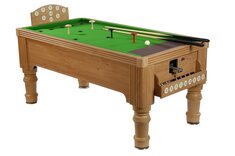The Rules of Indoor or Step Quoits
Indoor Quoits is popular on both sides of the Welsh/English border but its heartland is probably Evesham, England. Being a traditional pub game without any national governing body, variations of equipment and rules abound. Where there is doubt, locally played rules should always apply. Please note that 1 yard = 3 feet = 36 inches = 0.9144 metres.
See also: Indoor Pub Quoits (Step Quoits).
Description
Also known as Pub Quoits, Dobbers, Table Quoits, Step Quoits and Evesham Quoits, Indoor quoits is a miniaturised indoor version of the outdoor game that is played on a board around 18" square and usually brightly coloured in red, green and black. It is put on a table about 2ft 6 in high. The board features the main "spike" or "peg" in the middle and around it, two slightly sunken concentric circles. Quoits that lie on the border between the inner and outer circles count as per the outer circle. If any part of a quoit lies outside the outer ring perimeter, it does not score. The four quoits are made of rubber, black on one side, white on the other and any quoit that falls black side up, does not score. Two different games follow which are based on games played in pubs around Powys, Wales and Evesham, England.
Evesham Rules
The Evesham rules dictate that the thrower stands exactly 10 feet from the spike. Players toss a coin to decide who starts and take turns to throw all four quoits at the spike. Scoring is 5 points for the spike, 2 points for the pan (the inner circle) and 1 point for the outer circle. The aim is to be the first to score 61, the score typically being recorded on a cribbage board. An exact score is required to finish the game; if the score goes over 61, the player is bust and the score for that turn does not count. If the player who begins the game reaches 61 first and the opponent is 20 or less behind, the opponent is allowed to take a final turn in an effort to square the game.
The Powys Game
The Powys game has the thrower standing 8 feet, 6 inches from the front of the board. A special scoreboard exists, inscribed with the numbers 1 - 13 and with sliding covers called cards so that each number can be covered up. The spike scores 5 points, the pan (inner circle) 3 points and the outer circle just 1 point. The points scored each turn are totalled and if that total amounts to a number which is still available (not covered by a card), that number is claimed by the player and "closed" - covered by a card. The player's score is the sum of the numbers claimed by that player. It may not be necessary to close all the numbers in order to win the game because sometimes the total of the remaining numbers is not enough to catch the leading player even if they were all to be claimed. Luke Turner has given the following additional information. "In the Aymestry league we play numbers 1 to 11, and each player has to get all of them, then 12 is put up, then 13 etc. In the Kington and Presteigne league we play numbers 1 to 13, yet only 11 cards have to be got, then if needed the remaining two, and then finally 14 and 15 are put up, then 16, then 17. Apparently, some places around Powys score the spike as 4 points, instead of 5.
These rules are provided by Masters Traditional Games, an Internet shop selling quality traditional games, pub games and unusual games. For general information or for copying and copyright, see our Rules Information page.
Our rules are comprehensive instructions for friendly play. If in doubt, always abide by locally-played or house rules.
Copyright James Masters, 2025. All rights reserved.


























